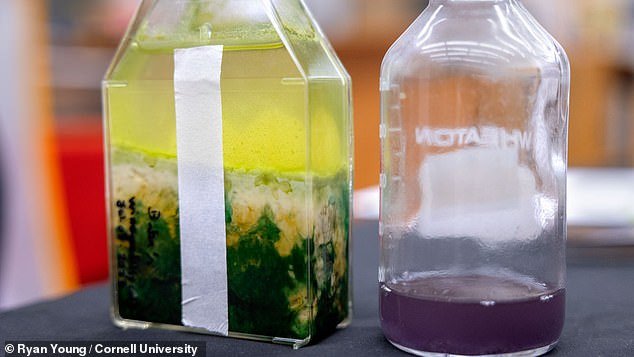Is this the key to finally finding life beyond Earth? Planets hosting aliens may give off a distinctive purple hue, scientists say
- Scientists have cataloged the colors of a range of organisms and minerals
- Analysis suggests that purple bacteria could be found on planets orbiting red dwarf stars
It’s one of the biggest unanswered questions in science: Is there life beyond Earth? And if so, where is it hiding?
Now scientists at Cornell University think they have taken a major step forward in the search for aliens.
In a new study, they claim that planets harboring alien life may emit a distinctive purple hue.
“We’re just opening our eyes to these fascinating worlds around us,” said Dr. Lisa Kaltenegger, co-author of the study.
“Purple bacteria can survive and thrive in so many different conditions that it’s easy to imagine that purple might be the new green on many different worlds.”
Scientists at Cornell University believe they have taken a major step forward in the search for aliens. In a new study, they claim that planets harboring alien life may emit a distinctive purple hue (artist’s impression)
Life on Earth is usually associated with a familiar shade of green.
However, life on other planets can be very different.
In their new research, the team wanted to understand what alien hunters should be looking for.
“We need to create a database for signs of life to ensure that our telescopes don’t miss life if it doesn’t look exactly like what we see around us every day,” said Dr. Kaltenegger.
The researchers cataloged the colors and chemical characteristics of a wide range of organisms and minerals.
Their analysis showed that purple bacteria can use invisible infrared radiation to power photosynthesis.

The researchers cataloged the colors and chemical characteristics of a wide range of organisms and minerals. Their analysis showed that purple bacteria can use invisible infrared radiation to power photosynthesis
For this reason, purple bacteria were likely present on early Earth even before the advent of plant-like photosynthesis, the researchers said.
“They already thrive here in certain niches,” says Lígia Fonseca Coelho, first author of the study.
Beyond Earth, purple bacteria could be particularly suited to planets orbiting cooler red dwarf stars – the most common type in our Milky Way.
“Imagine if they didn’t compete with green plants, algae and bacteria,” added Dr. Coelho adds:
‘A red sun could provide them with the most favorable conditions for photosynthesis.’
Furthermore, the researchers say that these worlds would produce a distinctive ‘light fingerprint’ that we could detect with both ground-based and space-based telescopes.

Beyond Earth, purple bacteria could be particularly suited to planets orbiting cooler red dwarf stars – the most common type in our Milky Way
“If purple bacteria are thriving on the surface of a frozen Earth, an ocean world, a snowball Earth, or a modern Earth orbiting a cooler star, we now have the tools to look for them,” says Dr. Coelho.
The new study comes shortly after scientists suggested that alien life could be hiding much closer to home.
University of Washington scientists claim NASA could confirm alien life by 2030 if it launches its $178 million spacecraft to Jupiter’s moon.
NASA will launch its Europa Clipper in October for its five-and-a-half voyage to Europa, where it will spend four years exploring the icy moon.
In a recent study, researchers analyzed the instruments on board the craft and found that they are able to pick up a single living cell in a tiny grain of ice ejected from the moon’s oceans.
